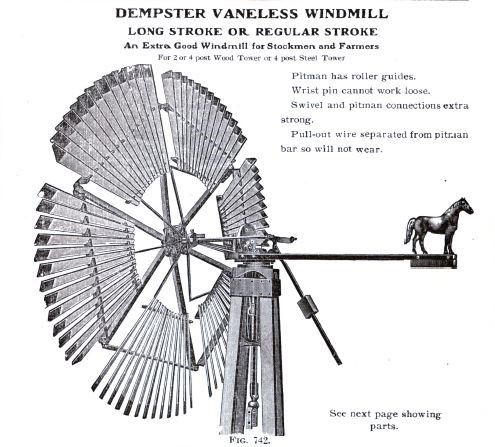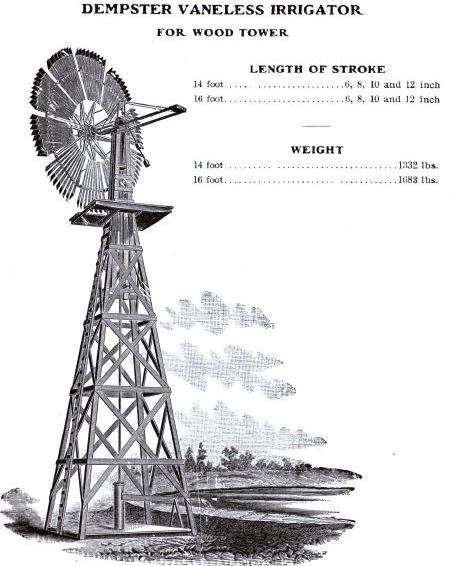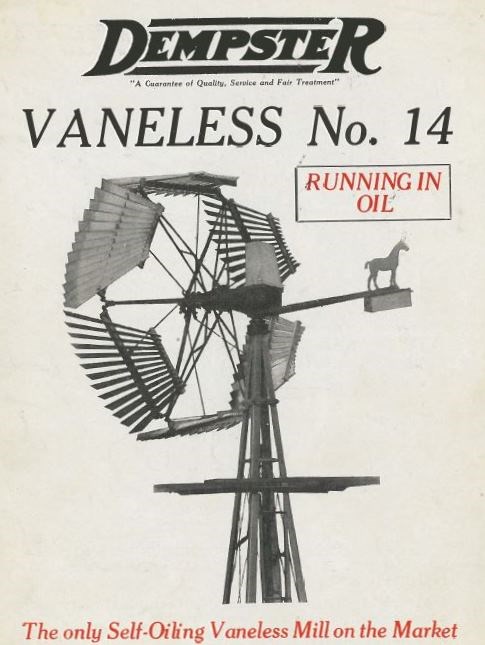Last updated: August 3, 2019
Article
Dempster Vaneless Windmills

NPS/Dempster Archive
By the 1880s, wooden vaneless windmills were growing in popularity across the central Great Plains. These windmills had hinged sections that could pivot in and out of the wind individually. This allowed them to govern the speed of the mills as the wind changed. Their movement somewhat resembled the opening and closing of an umbrella. Because they had no vanes or tails to direct them into the wind, their wheel operated downwind.
For over fifty years, the Dempster Mill Manufacturing Company produced vaneless windmills. Some were designed for ordinary farm and ranch use, while two heavy-duty models were produced for larger-volume pumping of irrigation water. The No. 14 holds the distinction of being the only widely sold oil-bath vanless mill produced in America.
Original Dempster Vaneless (1895-1900)
The Original Dempster Vaneless mill used a sectional wheel made up of thin wooden blades. The wheels were dipped in white lead paint and the blade tips trimmed in red. The company kept this color scheme from this time onward.
The stronger the wind, the more the blades tended to push backward, a tendency enhanced by centrifugal force. This lessened the wheel surface exposed to the wind and created a large opening in the center, slowing the rotation speed of the wheel. As this occurred, a weighted lever then pulled the sections back to face the wind when the wind subsided. To turn off the mill, a wire was pulled to lift the weighted lever and draw the wheel sections out of the wind.
The Dempster Mill Manufacturing Company sold its Original Dempster Vaneless windmills in 10, 12, and 14-foot diameters. This mills did not have a counterbalance weight. This meant that the weight of the wheel always pulled the mill to one side, causing wear to the windmill.

NPS/Dempster Archive
Dempster Vaneless Irrigator (1896-1917) & Double-Stroke Vaneless Irrigator (1896-1905)
In 1896. the company introduced two large vaneless models. These were created in response to farmers using windmills to pump water for irrigating crops. The Dempster Vaneless Irrigator was a heavy-duty variant of the Original Dempster Vaneless made in 12, 14, and 16-foot diameters.
The other new mill was the Dempster Double-stroke Vaneless Irrigator. It was unlike any other windmill on the American market. It was a back-geared wooden vaneless windmill designed to pump water on both the downstroke and the upstroke. The Double-Stroke mill had wheels in 12, 14, and 16-foot diameters.
The irrigator mills were the first Dempster vaneless mills to use a counterbalance weight. It was a rectangle of cast iron bolted to two horizontal bars horizontally from the head. The purpose of this weight was to balance the heaviness of the wheel so that the entire mill would move smoothly as wind directions changed.
In 1900, the company reduced the sizes in the Dempster Irrigator and the Dempster Double-Stroke Irrigator mills. The Dempster Vaneless Irrigator was available in 14 and 16-foot diameters, while the Double-Stroke Vaneless Irrigator was only made in the 12-foot size. The Double-Stroke Irrigator disappeared by 1905 and the Dempster Irrigator mill was discontinued in 1917.
Dempster No. 1 Vaneless (1899-1906)
The company introduced a new vaneless mill to take the place of the Original Dempster Vaneless in 1899. This was also when the company started numbering its models.
The No. 1 Vaneless windmill was almost the same as the Original Vaneless with counterbalance weight. This mill was the first to use the distinctive horse-shaped figure mounted on tops of metal boxes as a counterbalance weight.
The No. 1 Vaneless mills were made in 10 and 12-foot diameters and had either long or short stroke length. Customer initially had the option of ordering the mills with or without counterbalances.
Dempster No. 2 Vaneless (1905-1909)
The company created another new vaneless wooden mill, the Dempster No. 2 Vaneless in 1905. Made in 10 and 12-foot diameters, it used a similar counterbalance with a long-tailed horse and weight box.
The No. 2 can be distinguished by its unusual profile. The weighted governor lever was angled awkwardly the top of the crank plate and the main casting. This design must have presented problems for the company as they discontinued the No. 2 Vaneless mill by 1909.
Dempster No. 3 Vaneless (1906-1917)
The Dempster No. 3 Vaneless, was the first Dempster vaneless mill with wrought iron mast pipes. Having these metal mast pipes gave the mill greater stability. This mill also created a reciprocating pump stroke converting the rotary movement of the wheel. These mills were made in 10 and 12-foot diameters.
Dempster No. 3 mills had one major cosmetic change. The Dempster No. 1 and No. 2 mills used a counterbalance weight in the shape of a horse with a long tail. The long tails on these casting were difficult to pour at the foundry. To increase efficiency of production, the cast iron horse figures were simplified to have short tails instead.
Dempster No. 4 Vaneless (1916-1925)
In 1916, the Dempster Mill Manufacturing Company introduced another vaneless mill, the Dempster No. 4 in 10 and 12-foot diameters. These new mills retained most of the design features of the Dempster No. 3. One difference was the diagonal steel brace connecting the weighted lever and the shifting rods to the top of the mast pipe. This reinforced them substantially.
Dempster No. 4 Vaneless windmills were popular across the Great Plains including the prairie provinces of Canada. The No. 4 was on the market during a prosperous time for many farmers and stock raisers.

NPS/Dempster Archive
Dempster No. 14 Annu-Oiled Vaneless (1923-1941)
By the mid-1910s, windmill manufacturers began marketing self-lubricating “oil bath” metal windmills. In 1923, Dempster applied this technology to its wooden-wheel vaneless line with the 10-foot Dempster No. 14. This mill was the only widely-distributed oil-bath vaneless mill produced in the United States.
The main casting on the Dempster No. 14 served as its oil reservoir. A galvanized sheet metal hood covered the moving parts of the mill that were being oiled.
The Dempster No. 14 was the only vaneless mill made by Dempster that used a governor spring. Mounted around the main shaft in the main casting, it was flooded with oil. This spring kept the wheel sections squarely facing light winds. When stronger winds forced the wheel sections to pivot, the pressure from the spring brought them back to face the wind when it subsided.
The Dempster Mill Manufacturing Company marketed the No. 14 oil-bath vaneless mills through the 1920s and 1930s, though they never were big sellers. The last of the Dempster vaneless windmills went off the market in 1941.
Sources
- Baker, T. Lindsay. 1984. A Field Guide to American Windmills. Norman, Oklahoma: University of Oklahoma Press. p. 186-187.
- Baker, T. Lindsay. 2001. "Wooden Vaneless Windmills Made by the Dempster Mill Manufacturing Company." Windmillers’ Gazette. XXIX, No. 1 (Winter 2010) p. 2-9.
- National Park Service. Homestead National Monument of America. Dempster Mill Manufacturing Company Records, 1878-2010.
Prepared by Amy Neumann, 2019
